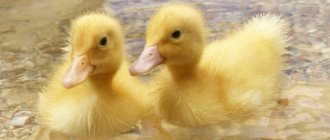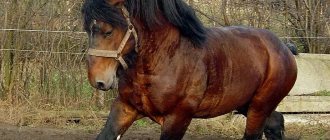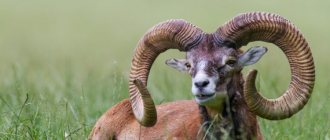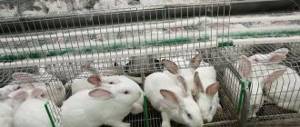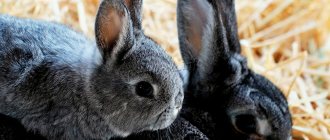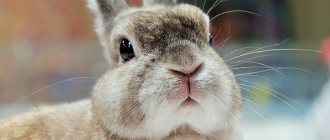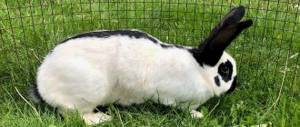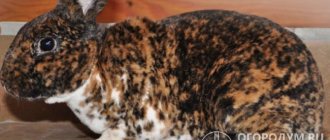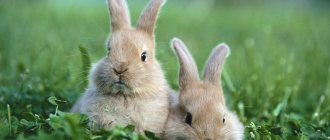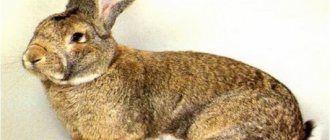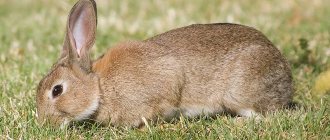Appearance
Marder rabbits are unique in appearance and are very difficult to confuse with any other breed. These animals have characteristic darkening on the limbs and face. The fur color can be light brown or with a dark shade.
Today there are two types of marder:
- big Marder;
- Soviet Marder.
The Great Marder has a strong body structure, with a slightly arched back. The small muzzle does not have a dewlap, the only exception may be the female, but this phenomenon is quite rare. Another feature is their strong paws, due to which they lead a very active lifestyle.
An adult is quite massive and can weigh about 5 kilograms. Standard weight is from 3.8 to 4.6 kg. Their fur is especially beautiful, which, due to the presence of chinchillas in the pedigree, is several times shorter than that of other breeds, while creating a kind of velvet effect that is incredibly pleasant to the touch. The color itself is quite beautiful, which can easily be confused with a marten.
Soviet Marder
Rabbits of the Soviet Marder breed are quite similar in design to their German counterpart. They also have a strong and fairly well-built physique. Also characteristic is a small head and small ears, a slightly lowered croup and straight legs - in appearance, these two varieties are practically no different, but rabbits of the Soviet Marder breed reach a weight of no more than 3.8 kg. This factor often misleads novice rabbit breeders, so it is best to purchase from trusted people.
The body length of the Soviet Marder varies within 50 cm, and the chest circumference does not exceed 35 cm. Let us also note the hairline, the density of which is 22,000-24,000 hairs per 1 square centimeter.
Features of the Soviet Marder rabbit breed
Rabbits of the Soviet Marder breed are bred mainly to obtain fur, which has high qualities: elastic, shiny and very thick. The color of the marder can be light or dark brown with darkening on the face, paws and tail. The skins of these rabbits are similar in appearance to the fur of martens, hence the name of the breed - marder (marten). This species was bred in the Armenian SSR in the 30-40s of the 20th century as a result of complex crossing of Russian ermine rabbits with the chinchilla breed. The female rabbits of the Soviet Marder are very fertile, they can give birth to 10-12 rabbits.
The Soviet marder is distinguished by a proportional and strong physique. A full-fledged representative of this breed should have a small, rounded head, small ears, a dense body (about 50 cm), a wide chest (circumference about 35 cm), a short, slightly rounded back, a significantly lowered croup, straight, strong paws. Adult rabbits should weigh about 3.8 kg.
Appearance and characteristics
Rabbits of the Marder breed are easily recognizable due to their unique color. Darkening on the paws and muzzle of a brown or blue color can be seen very clearly. All Marders have strong bones, a powerful build, small ears and heads, straight legs and a drooping rear part of the body.
The Big Marder breed is highly fertile. In one litter you can get up to 10 rabbits. Babies are born very small, weighing about 60 grams. However, thanks to the care of the rabbit, they quickly gain weight and already weigh about 0.6 kg per month. The young animals have a pale color, which after the first molt at the age of 4 months becomes brighter and more saturated.
Appearance of the species
Rabbits were bred in the Armenian SSR under the leadership of M.G. Bagratyan. through complex reproductive crossing. The ancestors of the species were: Russian ermine, large chinchilla, which transferred the special softness of fur to the new breed. As well as local blue rabbits, which were small in size.
Rabbit of the Soviet Marder breed
So, in 1940, the Soviet Marder breed was approved. Initially, it was not the largest in size (3.8–4.3 kg on average), but the quality and color of the skins distinguished the Marder from other breeds. Thanks to her, rabbits got their name.
Rabbits have a compact, dense build, with a body about 50 cm long. The following characteristics of the breed are distinguished:
Rabbits of the Soviet Marder breed are usually bred for fur. The skins of these animals are valued for their elastic, thick and soft pile. What kind of care does this rabbit need? How to choose it correctly?
Soviet marder rabbit
Big
Big Marder is a rabbit with dense thick fur, in which there is a large number of guard hairs. The body weight of these animals averages from 3.5 to 4.5 kg. Maximum weight – 5 kg. Other characteristics of this breed variety:
- absence of dewlap in males; in females it is less pronounced;
- strong strong paws;
- arched head shape;
- thin and short guard hairs.
The Big Marder breed is highly fertile. In one litter you can get up to 10 rabbits. Babies are born very small, weighing about 60 grams. However, thanks to the care of the rabbit, they quickly gain weight and already weigh about 0.6 kg per month. The young animals have a pale color, which after the first molt at the age of 4 months becomes brighter and more saturated.
The body length of the Soviet Marder varies within 50 cm, and the chest circumference does not exceed 35 cm. Let us also note the hairline, the density of which is 22,000-24,000 hairs per 1 square centimeter.
Reproduction
The female mardera is quite fertile - in one litter she can bring up to 10, and in some cases more, rabbits. Her maternal instinct is not very well developed, so from the very beginning of pregnancy and up to adolescence, it is better to monitor the young and the mother in order to avoid death. After all, baby rabbits are born weighing only 60 grams, but with the right approach to feeding the female, the young ones grow quite quickly and become independent. So, by the 30th day, the newborn reaches a weight of more than 500 grams, and by 4 months it already gains more than 3 kg. After reaching 4 months of age, young individuals begin to molt, and the faded, sparse fluff begins to become overgrown with massive, thick fur. By 6 months, rabbits already acquire their characteristic marten color.
When buying a marder, as when buying other breeds of rabbits for further breeding, it is best to contact different sellers or farms. The fact is that in the case of this breed, mixing of blood is not advisable, which can lead to a lack of luxurious fur or early death of the young.
Soviet marder rabbit
Rabbits of the breed ⇒ Soviet Marder were bred in the Soviet Union in the 30s and 40s. This breed is the result of complex and long reproductive crossing. First, Russian ermines were crossed with Soviet Chinchilla Rabbits. The resulting cross was crossed with local (this was in Armenia) outbred rabbits blue color. The offspring obtained after crossing were crossed again with Chinchillas and Russian Ermine. The result of such a long crossing were rabbits with thicker and shorter hair than the original breeds. Their spine is somewhat thinner and almost twice as short as that of normal-haired ones rabbits. Down hairs have the same length as guard hairs. The fur of short-haired rabbits of the Soviet Marder breed turned out to be soft, velvety and pleasant to the touch, which could not interest workers in the fur industry. The color range of rabbits varies from light brown to dark brown, but the tail, ears, paws and face are a little darker. Since the rabbits of the Soviet Marder breed are similar to martens, this is where the name came from. The skin of rabbits in its beauty ranks high among other breeds of rabbits and has great prospects for breeding.
The Soviet Marder rabbit has a strong constitution and a proportional build. Their head is small and round, a wide and deep chest without a dewlap, the back is slightly rounded and short, the limbs are straight and short. Adult Soviet Marder rabbits (during the period of work on the breed) weighed about 3.8 kg, with a chest girth behind the shoulder blades of 35 cm and a body length of about 50 cm. After carrying out work to improve the breed (work was carried out at the Armenian Research Institute of Animal Husbandry and Veterinary Medicine), the breeders managed to improve the quality indicators of the breed. The weight of the rabbits was increased up to 5.0-5.4 kg, the body length also increased and amounted to 55-60 cm, and the chest circumference reached 38 cm.
The average fertility of a female rabbit is 7 babies per litter, and the best female rabbits give birth to 10-12 babies. The babies of the Soviet Marder are born a little lighter (gray in color) and only by 4-5 months they acquire the color characteristic of adult animals. In terms of early maturity and energy young animals are more likely to have average growth rates and at one month of age the rabbit will gain weight of 400-650 grams, and at 1.5 months the baby’s weight will reach 750 grams - 1.0 kg. But it also happens when baby rabbits at 2 months weigh 1. 6, and at 3 months - 2.2 kg. Consumption of feed units per 1 kg. the increase in live weight is on average 4-5 kg. The slaughter yield is currently 60% (in the past the slaughter yield was 55%). Soviet Marder rabbits have a beautiful brown hair color. But the tone is not uniform in different animals, and so The same is true for one animal in different parts of the body. Their face, tail, ears and paws are much darker than the color of the fur of the entire body. The body itself is uniformly dark brown.
The color of the skin of Soviet Marder rabbits is very beautiful and in industry they are mostly used in their natural form. Dark brown skins are in great demand, and light brown ones are also of some interest. But, when sewing fur products using light brown skins ( due to the unevenness of their coloring) difficulties arise with the selection of fur. The quality of the skin obtained from a rabbit is reduced due to uneven hair color and the presence of white hair.
Rabbit breeders fell in love with Soviet Marders for their thick, shiny fur and original coloring. Their skins do not require dyeing. They are used only in their natural form. But they are not adapted to the cold, so these rabbits are bred only in the south and, as a rule, they can be found in farmsteads farms of amateur rabbit breeders.
Rabbits love corn
You might be interested
Rabbits of the Alaska breed
Rabbits of the Alaska breed ⇒these are meat-skin rabbits. This breed is not large in size, with black and shiny fur and a bluish undercoat. The breed was bred in the 70s of the 18th century in France...
Rabbit breed Soviet Chinchilla
The Soviet chinchilla rabbit breed is the result of the work of Soviet breeders. Work on the creation of the breed was carried out from 1947 to 1963 on the farms of the Research Institute of Fur Farming and Rabbit Breeding, in Cherepanovsky, Novosibirsk Region. And …
Angora down rabbit. Angora dwarf rabbit
The name Angora rabbit combines several breeds of rabbits, distinguished by their increased fluffiness to one degree or another. The Angora down rabbit breed is more common in European countries. Angora rabbits are medium in size. The color of the hair is different ...
Californian rabbits
Rabbits of the Californian breed were bred in the USA in California in the 20s of the last century. And to this day this breed is considered one of the most productive. Californians came to our country about ...
Rabbits Big Marder
Big Marder rabbits (imported from Europe) are little known to Russian rabbit breeders. Translated from German, the name of the rabbit breed – Marder – means marten. This name was given due to the great external resemblance to marten fur. The fur …
Feeding
Rabbits marder
need proper, and most importantly balanced nutrition.
The main aspect when feeding is variety
, with a rational content of all necessary minerals, vitamins and nutrients. Also make sure that the marder’s menu includes root vegetables, preferably raw, which contain the maximum amount of vitamins.
It is worth considering that Marder rabbits have a sensitive digestive system, so it is better to throw away products whose quality you doubt. Otherwise, the animal may be poisoned. The first signs of disease and infection are a wet muzzle or purulent lacrimal glands. If such symptoms appear, you should immediately contact a specialist.
Don't forget about drinking. Rabbits should always have a filled drinking bowl with clean water. Water should be changed at least once a day, preferably every 12 hours, and even more often in hot weather and during the childbearing period.
Keeping and caring for a Marder rabbit
The silky fur coat of Marder rabbits cannot be confused with any other. But in order for it to remain that way, special care is required.
They are best adapted to the southern regions. Marders do not tolerate dampness or drafts. Both factors have a detrimental effect on the psychological and physical state of individuals. If the cage is not cleaned on time and mold has grown in it, an adult rabbit may refuse to eat and become lethargic and inactive. In addition, the very appearance of the fungus is dangerous to the health of the animal. It should also be said about drafts, to which the breed is very sensitive. When placing cells, these factors should be taken into account. For the winter, you need to take care of insulating the room. It would also be a good idea to pour in more straw, in which the marder can hide from severe frosts.
Another important point - when installing the cages, make sure that there are no sources of sharp or loud sounds nearby. Marder rabbits are very sensitive to noise effects. If the room where the individual lives is clean, warm and dry, your ward will thank you with rapid growth and systematic development, large offspring, and, of course, its irresistible skin.
Maintenance and care
The marder rabbit is a heat-loving animal and cannot tolerate cold and dampness. Drafts can cause rhinitis. The cage should be dry and warm. For the winter, the cages are insulated and more straw or sawdust is placed on the floor.
Animals often suffer from diseases of the gastrointestinal tract; rotten vegetables and low-quality feed should not be fed to them.
Marders are shy and do not like sharp sounds. Place cages away from operating machinery and other sources of noise.
Pets require good care. Otherwise, they grow poorly, the fur coat looks faded and unattractive. And a mother rabbit may refuse to feed her babies, or even eat them, if some elements are missing in her food, or if there is no fresh water in the cage.
Value
The main value of the marder rabbit is its high-quality fur. It is used as raw material for fur products, such as coats or small fur capes. Due to the fact that the thermal insulation qualities of fur are not at the highest level, the skin of this breed is not suitable for fur coats. Rabbits of this type can also be classified as medium-sized meat breeds, because their weight is quite substantial, especially for a large marder, and the muscle mass is very compact and dense.
Comments:
Expand comments
